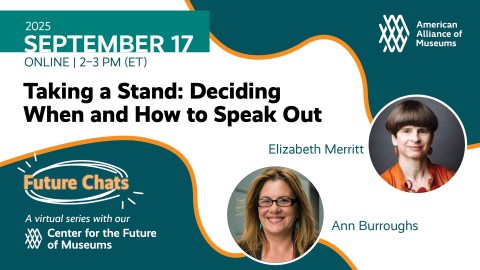
“It’s so good to see you!”
How much new meaning has that simple phrase taken on over the last two years?
Last September I attended my only in-person conference since the beginning of the pandemic (the AASLH Annual Meeting in Little Rock, Arkansas). I knew I had been missing in-person conferences. Museum people often speak a common language, feel a shared purpose, and encounter similar challenges and experiences, and there’s a certain indescribable feeling when we get together. I don’t want to dismiss online conferences—I have been to many and presented at a few, and they are excellent in their own way! But there was something different about getting to meet in person again. What was it exactly?
For me, it was the chance to talk with presenters or fellow attendees before or after particular sessions. It was the impromptu conversations that came up between sessions, in the exhibit hall, or on the bus to an evening social event. Over the years those have been some of my favorite conference experiences: the chance to learn something new in a way that can never really be formally programmed, but just happens organically. These are the chances to share that one vexing problem or help someone with theirs, in a way that only a random, spontaneous encounter can provide.
All of which is in addition to the conference program, of course. This schedule for this year’s AAM Annual Meeting & MuseumExpo in Boston looks compelling, and I have already been marking off sessions I plan to attend, including “Measuring Social Impact for Strategic Change”—as museums continue to push for justice (and as funders look for measurable results), it’s helpful to know how to make those programs as effective as possible. One of the first things I noticed about the program was that each day has a unifying theme, launched with its own keynote and followed by several relevant sessions. This type of scheduling provides a thematic linkage throughout the conference, grounding everyone in a common experience and helping to guide the conversations for the rest of the day.
Those of us with small museum backgrounds know the importance of making connections and how much harder that has been over the last two years. It’s part of what excites me about attending this year’s conference. I already plan to meet up with some colleagues from other small museums and historic houses and share ideas. Whatever your background, there will be other attendees who share it.
If you are a first-time attendee, the best advice I could give is to make it your experience. Listen to recommendations, but in the end, you know your own interests better than anyone else. Try something new! Don’t be afraid to experiment or attend a session that may be outside your specialty. Attend a workshop, if you can—that’s where you can really get in-depth experience with a subject and learn from the best. Check out the poster sessions, which are often fascinating and give you the opportunity to have a good conversation with the presenters. Just remember that this is your AAM experience! Make the most of it and you’ll learn a lot and have fun doing it.
Plus, the Red Sox will be in town every night of the conference. Maybe I’ll see you at Fenway Park!









